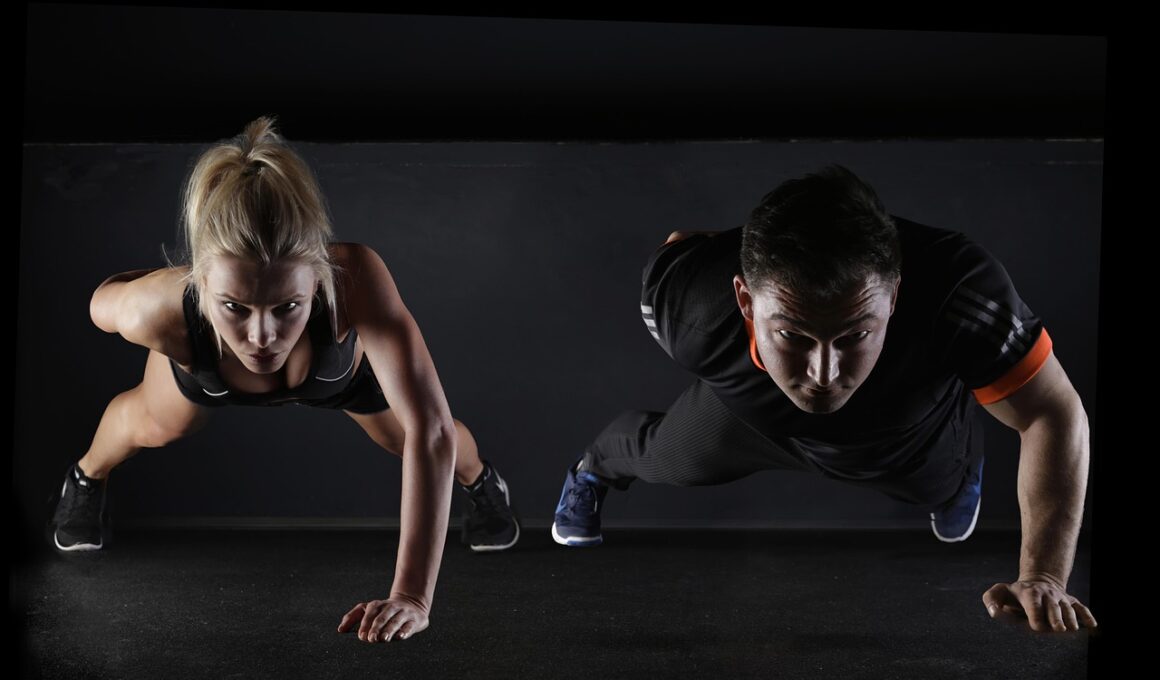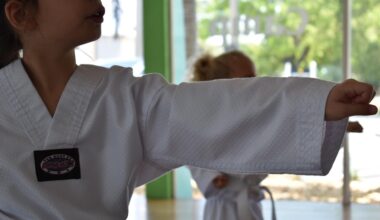Managing Muscle Soreness to Enhance Plyometric Safety
Plyometric training is highly beneficial for athletes seeking to improve explosive strength and power. However, to maximize its effectiveness, it’s essential to manage muscle soreness. Soreness can reduce performance and increase the risk of injury, so strategies must be implemented. First, prioritizing proper warm-up routines is crucial; such routines prepare muscles and improve flexibility, thus reducing soreness. Additionally, targeting muscle groups through balanced exercises enables adaptations with less stress on specific areas. Adding variability in training routines ensures all muscles receive attention, avoiding overuse injuries. Cooling down post-workout helps too, as it promotes recovery. Nutrition plays a vital role in soreness management; a diet rich in proteins aids recovery. Hydration is also critical; it ensures muscle tissues remain pliable and reduces stiffness. Lastly, incorporating rest days into the training schedule is imperative. These days should include active recovery strategies, like light stretching or low-intensity activities, which enhance blood flow and decrease muscle tension. Altogether, acknowledging and managing muscle soreness is key to safe and effective plyometric training.
Understanding muscle soreness can enhance performance in plyometric training. Delayed onset muscle soreness (DOMS) can occur after intense physical activities, particularly ones involving eccentric movements, common in plyometrics. It can lead to feelings of stiffness, swelling, and pain. Importantly, this natural response to stress typically indicates that muscles are adapting, suggesting the body is building strength and endurance over time. Awareness of muscle soreness is vital for athletes and trainers alike. Tools such as foam rollers can alleviate soreness as they promote circulation. Furthermore, consistency in training leads to adaptations that reduce soreness over time. As adaptations occur, the body becomes more resilient to training loads, resulting in less pain. Additionally, understanding the importance of listening to one’s body can prevent exacerbating sore muscles. If soreness becomes severe, it might be necessary to modify the training regime temporarily. Utilizing modalities for recovery, such as ice baths and compression garments, can expedite healing. Finding a suitable balance between pushing limits and allowing time for recovery is fundamental for athletes engaged in rigorous plyometric activities.
Recovery Techniques for Plyometric Athletes
Recovery is an integral component of plyometric training, particularly for managing muscle soreness. One effective technique involves proper nutrition, which is essential for muscular repair and recovery. Consuming protein-rich snacks post-exercise replenishes lost nutrients. Additionally, carbohydrate intake aids in restoring glycogen stores used during intense workouts. Hydration cannot be overlooked either; drinking water before, during, and after training sessions supports overall recovery and muscle function. Another recovery strategy includes active recovery sessions, which consist of low-intensity exercises. These sessions help improve blood flow to muscles, facilitating nutrient delivery and removing metabolic waste. Techniques such as yoga and gentle stretching can enhance flexibility, reducing muscle tightness following plyometric workouts. Massage therapy is also beneficial, as it aids in the alleviation of soreness and tension, promoting relaxation. Fans of contrast baths, alternating between hot and cold water, claim they aid in recovery by assisting circulation. Lastly, adequate sleep is often underestimated yet is crucial for optimal recovery and muscle repair. Inadequate rest not only prolongs soreness but also hinders overall athletic performance.
Mindset plays a vital role in managing muscle soreness effectively. Athletes should approach training with a positive attitude to foster resilience towards discomfort. Establishing realistic expectations around soreness can delineate normal recovery experiences from potentially harmful conditions. Incorporating gentle affirmations and visualization can change the perception of soreness, promoting a healthier outlook towards flexibility and training adaptations. It’s crucial for athletes to recognize that soreness is often a temporary condition, and flexibility in adjusting one’s training is essential for long-term success. Developing coping strategies becomes paramount, especially during periods of severe soreness. Implementing a supportive network, including trainers and peers, can provide encouragement and motivation in tough times. Whether through shared experiences or practical advice, community support can ease the mental burden of managing muscle soreness. Engaging in self-care activities like meditation, art, or journaling can also reduce stress and foster a positive mindset. Thus, addressing soreness holistically encourages athletes to embrace the physical challenges presented by plyometric training while promoting recovery and mental resilience.
Monitoring Progress in Plyometric Training
Monitoring one’s progress is paramount when engaging in plyometric training. Athletes need to track data related to muscle soreness and overall performance to copiously assess body responses. Keeping a training log that outlines exercises, soreness levels, fatigue rates, and recovery methods can provide essential insights. Additionally, evaluating metrics such as jump height, speed, and associated fatigue can highlight areas requiring focus or change. Utilizing wearable technology can revolutionize progress tracking; heart rate monitors and fitness trackers help gauge workout intensity and recovery status. Athlete feedback can inform necessary adjustments to the recovery strategies. Regular assessment of training outcomes allows for informed decision-making in managing soreness. Another method involves conducting periodic fitness tests to quantify physical adaptations over time. Tests assessing strength, endurance, and flexibility inform trainers about readiness to progress or adjustments needing implementation. Systematic evaluations create opportunities to align training objectives with performance goals. This measurement-centric approach can significantly enhance plyometric training efficacy and safety by ensuring that athletes remain within optimal performance thresholds while mitigating risks associated with muscle soreness.
A comprehensive warm-up crafted specifically for plyometric training fosters safety and effectiveness. Dynamic stretches incorporate multi-joint movements which prepare the body for high-impact activities. Such routines activate target muscle groups, enhancing neuromuscular efficiency and reducing the likelihood of injury or excessive soreness. Athletes should be encouraged to make warming up a habit, prioritizing exercises that mimic movements involved in plyometric activities. Gradually increasing the intensity of these warm-ups ensures that muscles are adequately prepared, improving their ability to absorb impact forces. A well-structured warm-up should include movements like lateral hops, arm swings, and light jogging. This foundational practice primes the body for subsequent training demands, ultimately promoting better performance outcomes. As muscles adapt over time, feedback from routine warm-ups encourages further personalized adjustments for each athlete, fostering ongoing improvement. Additionally, integrating balance and proprioception drills will contribute to overall body awareness, ensuring safer plyometric executions. By consistently engaging in structured warm-up protocols, soreness and injuries can be minimized. A proactive approach to plyometric training enhances safety while unlocking athletes’ explosive potential.
Conclusion: Balancing Safety and Performance
Achieving a balance between safety and performance in plyometric training demands diligence and awareness. Athletes must prioritize strategies for managing muscle soreness, understanding that consistent routine and proper recovery are key to success. Acknowledging the nature of muscle adaptation encourages athletes to embrace soreness without experiencing demotivation. This article highlights a variety of approaches including cooling down, nutrition, and structured warm-ups. It is critical to establish an individualized training plan that accommodates personal responses to training loads. Flexibility in practice allows for training modifications according to soreness levels, promoting continued progress without risking injury. Effective communication with trainers enhances athletes’ ability to voice discomfort, allowing for timely adjustments. Incorporating active recovery strategies contributes to overall well-being and fosters resilience. Finally, maintaining a positive mindset among athletes fortifies their journey through rigorous plyometric regimens. Ultimately, a systematic and thoughtful approach ensures that the pursuit of enhanced performance does not compromise safety. By embracing these principles of muscle soreness management, athletes can thrive in their plyometric training, achieving new pinnacles of fitness and strength.
Therefore, while muscle soreness is an expected aspect of rigorous plyometric training, proper management ensures athletes can navigate their routines safely without excessive discomfort. Seeking medical attention when soreness escalates or persists is advisable to rule out injuries, ensuring athletes can engage in training securely. Another preventive approach involves engaging professional trainers or physical therapists. Such professionals can develop individualized training plans that integrate recovery methods alongside progressive overload principles. Initiating plyometric training should always involve consultations to evaluate personal fitness levels and histories; especially for beginners, incremental loading is key to avoiding injuries. Consistent education on body mechanics and precise exercise techniques reduces excessive strain. Ultimately, by balancing rigorous training with smart recovery techniques, athletes can cultivate strength without jeopardizing their well-being. Plyometric training, when properly managed, will provide substantial returns in performance enhancements. This type of training can be transformative, building capabilities that enhance athletic performance across disciplines. With a focus on keeping soreness manageable, athletes can excel in their training endeavors, reaching new personal bests while remaining physically sound.


